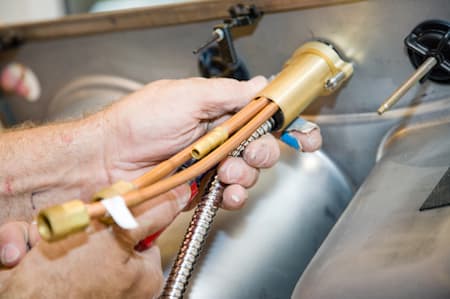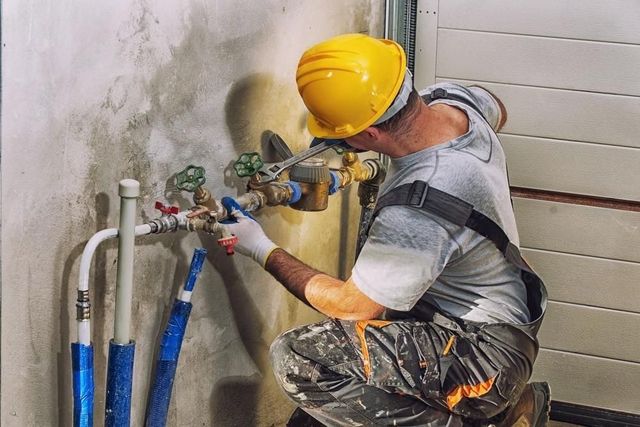Why Buying Repiping Providers Is Crucial for Your Home's Plumbing Wellness
Repiping services play an essential role in preserving a home's pipes health. In time, pipelines can wear away, leakage, or come to be clogged, resulting in possible threats and ineffectiveness. House owners frequently forget the indications of degrading pipes, which can lead to substantial damages. Comprehending the need for repiping is important. What variables should home owners consider prior to making this financial investment? The solutions may shock you.
Understanding the Importance of Repiping
While numerous house owners might ignore the importance of repiping, it plays a crucial duty in keeping the general wellness of a pipes system. Gradually, pipelines can rust, create leakages, or end up being obstructed with natural resource, bring about reduced water quality and flow pressure. Repiping addresses these problems by replacing old, damaged pipelines with brand-new, resilient products, ensuring a reputable water system and decreasing the danger of expensive fixings related to leaks and water damages. Additionally, modern-day piping materials are usually much more efficient and eco-friendly, adding to reduced energy expenses and enhanced water preservation. Performing a repiping project can enhance a home's resale worth, making it a prudent financial investment for homeowners. Inevitably, acknowledging the importance of repiping enables property owners to take proactive procedures in guarding their plumbing systems and guaranteeing a safe, useful living environment for their households.
Usual Indications That Suggest the Need for Repiping
House owners must be cautious for sure signs that indicate the demand for repiping, as ignoring these problems can lead to much more extreme plumbing issues. One typical sign is the existence of regular leakages, which can recommend aging or weakening pipes. Furthermore, a recognizable decline in water stress might suggest clogs or deterioration within the pipes system. House owners might likewise observe discolored or rusty water, indicating pipeline degradation. Unexplained water expenses that are markedly higher than usual can also mean leakages hidden within the wall surfaces. Additionally, the development of mold or mildew in areas near pipes components can suggest wetness problems coming from damaged pipelines. Ultimately, if the home has old galvanized piping, it may be time to think of repiping, as this product is prone to corrosion and corrosion. Identifying these indicators early can help maintain a healthy and balanced pipes system.
The Threats of Neglecting Pipes Issues
Overlooking plumbing issues can result in significant water damages, which might endanger the structural integrity of a home. Furthermore, unsolved leaks can produce a setting favorable to mold growth, positioning serious health and wellness threats to residents. Resolving plumbing problems immediately is important to guard both home and wellness.
Water Damages Problems
When pipes problems go unaddressed, the danger of water damage intensifies substantially. Leakages, leaks, and splits in pipelines can result in substantial water intrusion, jeopardizing the structural honesty of a home. Gradually, even small leakages can trigger rot, mold development, and damage to wall surfaces and flooring, leading to expensive repair work. Water damages can likewise influence electric systems, creating hazardous conditions. Home owners usually underestimate the cumulative effect of tiny leakages, which can bring about extensive damage otherwise quickly dealt with. Disregarding pipes concerns not only raises the probability of instant damages however can additionally lessen home value and position long-term financial worries. Therefore, timely repiping services are important to avoid water damage and keep a healthy home environment.
Wellness Hazards Rise
Unsettled plumbing issues can lead to considerable health and wellness threats within a home. Contaminated water from corroded pipes can introduce dangerous bacteria and lead to serious diseases. Mold growth, typically an outcome of leaks and excess moisture, positions respiratory system risks and can set off allergic reactions. Furthermore, stationary water can bring in bugs such as rodents and insects, which bring illness that further jeopardize family wellness. Ignoring these plumbing issues not only endangers the safety and security of homeowners however can also decrease home value. Addressing plumbing concerns with repiping solutions is important. Timely treatment not just safeguards wellness yet additionally assures a secure living setting, protecting against a lot more substantial damages and costly fixings down the line.
Different Kinds of Piping Materials
Piping products are an essential component in pipes systems, influencing sturdiness, efficiency, and overall performance. Various alternatives are available, each with special buildings and applications. Copper piping is understood for its longevity and resistance to corrosion, making it a prominent option for both cold and hot water lines. PVC (polyvinyl chloride) is lightweight, cost-effective, and resistant to chemical damages, mostly made use of for drainpipe and vent systems. PEX (cross-linked polyethylene) has obtained popularity due to its adaptability and simplicity of installment, enabling less joints and prospective leakage points. Galvanized steel, though once typical, is much less beneficial today as a result of its sensitivity to corrosion and decreased water flow in time. Each material offers distinct advantages and negative aspects, making it essential for house owners to talk to plumbing specialists to figure out one of the most suitable choice for their specific demands and conditions. Choosing the best piping material can considerably impact the effectiveness and safety and security of a pipes system.
The Repiping Process: What to Expect
The repiping process begins with a comprehensive analysis of the existing pipelines to recognize problems and identify official statement the ideal strategy. Following this assessment, house owners will need to select suitable substitute products that match their pipes requires. Ultimately, a summary of the installation process will certainly provide understandings right into what to anticipate throughout this considerable home renovation.
Assessment of Existing Pipes
An accurate evaluation of existing pipelines is necessary for making sure the long-term health and wellness of a plumbing system. This examination involves examining the materials, age, and problem of the pipelines, as well as identifying any type of indicators of corrosion, leaks, or obstructions - Houston Repiping. Expert plumbing professionals usually make use of innovative strategies such as video clip evaluations to acquire a clear sight of the pipe's interior without intrusive procedures. By recognizing issue locations early, house owners can protect against further damages and pricey repairs in the future. Furthermore, understanding the current state of the plumbing infrastructure aids in making notified choices concerning necessary upgrades or repiping. Generally, an extensive evaluation acts as the structure for a successful repiping process, making certain that the brand-new system fulfills the home's certain demands
Selecting Substitute Products
After reviewing the existing pipes, home owners encounter the essential choice of choosing ideal substitute materials for their plumbing system. Common options include copper, PVC, PEX, and CPVC, each with distinctive advantages and downsides. Copper is recognized for its longevity and resistance to rust, making it a resilient choice. PVC is lightweight and cost-efficient, ideal for drain and air vent lines. PEX supplies versatility and is resistant to scale and chlorine, making installation simpler in limited rooms. CPVC resembles PVC however can hold up against greater temperatures. Property owners must consider factors such as budget plan, local building ordinance, and the details requirements of their plumbing system when making this decision, making sure suitable performance and long life for their home's plumbing framework.
Installment Process Overview
Repiping a home can be a significant undertaking, however recognizing the setup process helps homeowners plan for what lies in advance. The process typically begins with a comprehensive assessment of the existing plumbing system to determine problem areas. Next off, a detailed strategy is formulated, detailing the required materials and timelines. On the installment day, specialists will typically start by shutting off the water supply and draining the existing pipes. They then eliminate the old piping, which might involve opening walls or ceilings for gain access to. Brand-new pipes are mounted, ensuring they fulfill current pipes codes. Lastly, the system is tested for leaks, and any openings are repaired. Homeowners can anticipate a tidy and reliable procedure, minimizing interruption to their everyday lives.
Long-Term Conveniences of Repiping Your Home
While several home owners may ignore the importance of upgrading their plumbing, like this the lasting advantages of repiping a home can substantially improve both its value and functionality. Among the primary benefits is improved water top quality. Older pipelines may nurture contaminants and corrosion, while brand-new piping assurances tidy and safe water shipment. Additionally, repiping can cause raised water pressure, making day-to-day tasks much more reliable.

Exactly how to Select the Right Pipes Solution for Repiping
Exactly how can property owners ensure they pick the most effective plumbing solution for repiping? They ought to look into regional plumbing firms, focusing on those that specialize in repiping solutions. Repipe Pros. Checking out online evaluations and testimonies can offer understandings into the top quality of service provided. It's important to examine for appropriate licensing and insurance policy, guaranteeing the picked company follow regional guidelines
Homeowners must additionally request comprehensive price quotes from multiple providers to compare prices and solutions offered. Engaging directly with possible plumbings can assist analyze their knowledge, interaction abilities, and desire to answer concerns. Additionally, requesting for referrals from previous clients can validate a company's integrity and handiwork.
Homeowners ought to think about the firm's service warranty plans on products and labor, as this can show their commitment to high quality. By complying with these standards, house owners can make an educated option, securing their plumbing health through effective repiping services.
Frequently Asked Inquiries
How much time Does a Typical Repiping Project Take to Full?
A regular repiping job generally takes in between one to 5 days to finish, depending upon the size of the home and complexity of the pipes system. Appropriate planning and professional know-how can influence overall period substantially.
Will Repiping Boost My Home's Resale Value?
Repiping often boosts a home's resale value, as prospective buyers value updated plumbing systems. This renovation minimizes potential pipes problems, making the building much more eye-catching and potentially justifying a higher asking price throughout sale settlements.
Can I Remain In My Home Throughout Repiping?
During repiping, remaining in the home is commonly possible, yet it may rely on the degree of the work. Home owners ought to plan for momentary disruptions and speak with contractors for certain arrangements and security considerations.
What Is the Typical Cost of Repiping a Home?
The ordinary expense of repiping a home typically ranges from $4,000 to $15,000, relying on elements such as the dimension of the house, products used, and labor expenses related to the plumbing job. - repipe specialist in houston
Do I Need an Authorization for Repiping Services?
A license is commonly required for repiping services, as it assures compliance with neighborhood building ordinance and guidelines. Home owners should consult their local authority or a qualified plumbing technician to establish specific permitting demands for their location.
